- Born in Victoria, British Columbia, Canada
- BFA (Honours), Department of Fine Arts, University of British Columbia, 1979
Statement
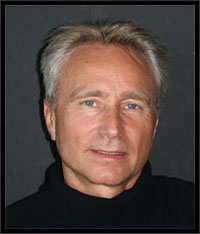
John Clair Watts
Having worked in the film industry for twenty five years as a set decorator, props designer and art director, I would have to say that it has influenced my work. Part of my job is to create imagined cultures. We read the script and interpret what we imagine would be the artifacts of this assumed society, some are past, some are future.
Going into the past often means envisioning something primitive depending how far back we need to go of course. Primitive is much more of a creative opportunity than having to address a “period” in time wherein you replicate that reality. In the opposite direction are science fiction movies where on has license to imagine what could be, trying not to duplicate what has already been done. Many times we have to invent technologies that support the concept that we are trying to manifest.
For the last number of years in my own works it appears that I have been creating societies or at lest the artifacts of societies that embody both of these extremes. I tend to want to balance something soft with something hard or in this case something primitive or warm against something hard. With this body of work I tended to work on both genres at the same time.
These artifacts of my societies usually have a hierarchical nature. The first complete community that I created was called Homefires wherein I had a temple, four power generators (social bishops) and a residential community that within itself had its own hierarchical or status related statement.
Many times my works are initiated by what materials I have at hand. I tend to collect and recycle materials that show up in my studio and start playing with them. I find this more satisfying than creating something that I have designed in advance. Although what I have always believed is that art is better serviced when it evolves from the process not an idea. Or at least when an idea is allowed to evolve as it progresses.
I’m always pleasantly surprised when something evolves to a place wherein I want to say thank you to my muse, subconscious or whatever gives me a sense of discovery upon seeing something realized. I openly feel like a prospector searching for gold, doing lot of mock ups before I actually see something I like.
In my current work, on the primitive side, I have again created a temple, a book (every society seems to have one), pages of the book, relics contained in reliquaries, and trees and forests. There are a number of vessels and an assortment of “tools” in this case spears and a protractor. The spears propping up objects intended as personal trophies of fetishes.
On the harder or more male side there are again “trees” of casting resin and black acetate, temples or reliquaries “wallpieces that protect or contain an inner core” of aluminium, stainless steel and casting resin. There is a shroud of nine-volt battery clips, a yin yang symbol of birds rising and falling with an eye in the centre made of aluminium, casting resin, stainless steel and copper intended to act as a logo, there is a jack in the box with black tendrils representing the unknown. There is also a forest of these same tendrils. Another work has a lit stainless centre with rubber threads (dark matter) supporting a centre intended to be something of value.
Not only do I tend to create works that are unto themselves hard or soft, but also I tend to try and balance or juxtapose the hard with the soft within each piece. Some hard on the outside and soft in the middle and others the reverse. Many times I ground something slick by incorporating a common object such as a name nail or wire or found object.
In terms of installing work, given that I have license to utilize the space as I desire, I like to control the environment especially the lighting and if possible use sound and movement.
All in all, having finished with a body of work I tend not to go back to that particular genre, instead I go back into my studio and start a new adventure.
–John Clair Watts, 2010
Resume
Exhibitions
- Apples & Oranges 2 (George Littlechild / John Clair Watts), Atrium, Vancouver, BC
- Patrick Doheny Gallery, Vancouver, BC
- Kenneth Heffel Inc., Vancouver, BC
- Open Space Gallery, Vancouver, BC
- The Jackson Street Gallery (Christine Raymond / John Clair Watts), Seattle, Washington, USA
- The Fine Arts Gallery, University of British Columbia, Vancouver, BC
Group Exhibitions
- The Group John Ramsey Gallery, Vancouver, BC
- Patrick Doheny Gallery, Vancouver, BC
- Canadian Craft Museum, Vancouver, BC
- Public Art & Art about Public Issues, Artropolis 1993, Vancouver, BC
- Lineages & Linkages, Artropolis 1990, Vancouver, BC
- Material Essence, The Surrey Art Gallery, Surrey, BC
- The Heffel Gallery, Vancouver, BC
- The Heffel Gallery, Vancouver, BC (2nd time)
- The Crown Gallery, Vancouver, BC
- Contemporary Living Show, Park Place, Vancouver, BC
- Banners, Splash, Arts Umbrella, Vancouver, BC
- Fall Gala Art Show, The New Play Centre, Vancouver, BC
- The Remy Martin Canadian Art Exhibition, Robson Square, Vancouver, BC
- The Issacs Gallery, Toronto, Ontario, Canada
- Vancouver Art and Artists, The Vancouver Art Gallery, Vancouver, BC
- The Bishop Romero Show, The Unit Pitt Gallery, Vancouver, BC
- Shoot That Tiger Gallery, Vancouver, BC
- Intersections, The Franz Wynans Gallery, Vancouver, BC
- Under Thirty Show, The Klee Wyck Gallery, West Vancouver, BC
- The Sub Gallery, University of British Columbia, Vancouver, BC
- The Gordon Galleries, Vancouver, BC
Commissions
- Whistler Westin Hotel
- Canada and the Arts, Canada Place Pavilion, Expo ’86, Vancouver, BC
Performance Works
- Gathie Falk: Skipping Ropes, A bird is known by his feathers alone, Act One, Scene One and Two, Before and After, Ballet for Bass and Baritone, Chorus, Low Clouds and Orange
- Tom Graff: Tom’s Diary
Collections
- Valhalla Mineral Resources Ltd., Vancouver, BC
- Museum of Civilization, Hull, Quebec
- Sheinnen & Co., Vancouver, BC
- Westin Grand Hotels, Vancouver, BC
- Walker McTavish Collection, Vancouver, BC
- Barb and Ken Cross, Vancouver, BC
- Westin Grand Hotels, Whistler, BC
- Various Private Collections
Reviews
- Art Moco, Featured artist
- Preview Magazine, February / March 1998, Mia Johnson
- The Vancouver Sun, Saturday Review, November 2, 1991, Heavy Metal Magic, Ann Rosenberg
- The Leader, April 1990, Unusual materials, Essence of art, F. Bucholotz
- Surrey Now, April 1990, SAG Gets down to material essence
- Art News, January 1984, Patricia Failing
- The Vancouver Sun, October 2, 1984, Sculptor doing more than just playing with Plexiglas, E. Johnson
- Vanguard Magazine, October 1984, John Clair Watts / Open Space, Ann Rosenberg
- Monday Magazine, Vol. 10, Issue 29, Watts’ black and glows, R. Amos
- The Province, July 3, 1983, Artful mix of talents, Art Perry
- The Province, July 3, 1983, Art Forum offers fresh air and energy, Art Perry
- The Vancouver Sun, Artseen, S. Mertens
Publications
- Public Art & Art about Public Issues, Artropolis 1993 catalogue
- Lineages & Linkages, Artropolis 1990 catalogue
- Vancouver Art and Artists – 1931 to 1983, published by The Vancouver Art Gallery
- The Capilano Review, Issue no. 21, an Interview by A. Rosenberg
Television Interviews
- CBC, The Arts Report with Dale Drury
- VTV, Arts & Entertainment, February 16, 1998 (Artist Profile with Karen Firus)
- CBC Television, Vancouver Life with Carol Taylor
- TV Channel 10, Art Forum
Grants
- British Columbia Cultural Fund
- British Columbia Cultural Fund (2nd time)
“Any work of art is a groping within a reality we believe may be revealed but in fact never is.” – Borges
SECTION 1: INSTALLATION – 2000-2010
The artifacts in this photograph were made for a “primitive” (present or future) society. Many objects, similar to those arranged in the studio shot (for example a total of 7 Buttresses and 9 Spears afford permutations for numerous, larger installations that could be placed in a variety of physical spaces.
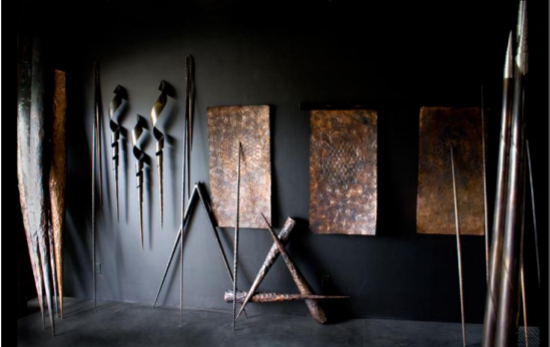
Some pieces exhibit complementary traits because they are in a similar style or utilize similar materials. Balance is often achieved between hard and soft, low tech and high tech — not only in a particular sculpture but also in a number of works that must resonate with each other. In a few instances, I ground a piece I feel is too slick by juxtaposing it to one that is more natural, less polished. Photographs of objects (nos. 1 to 6) are close-ups of artifacts in the studio installation.
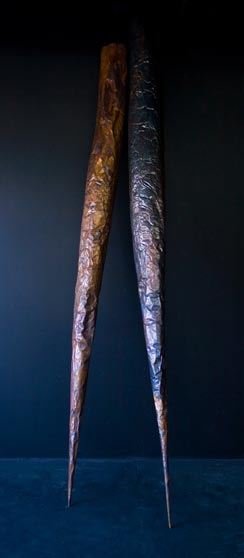 |
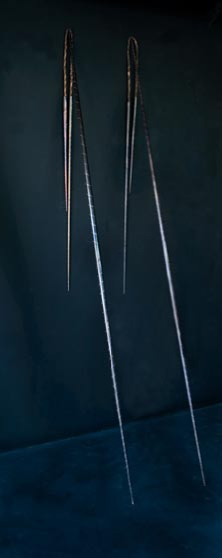 |
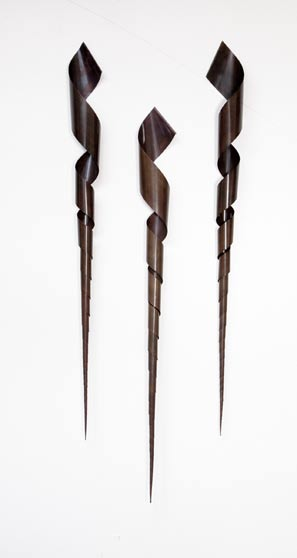 |
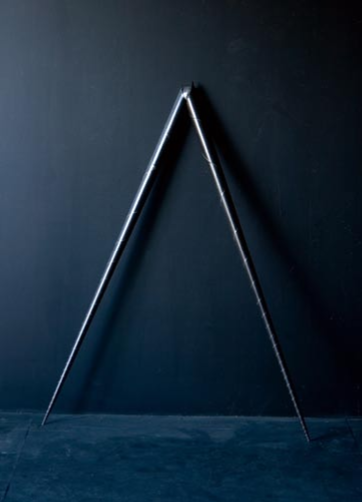 |
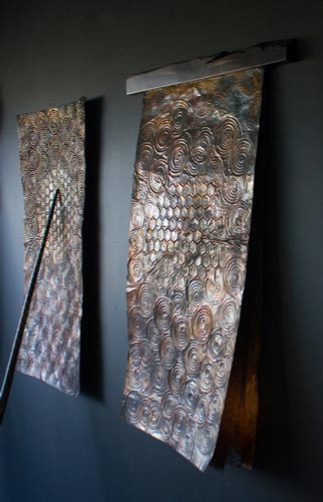 |
 |
 The following group (nos. 7 to 15) includes other objectsmade for the “primitive” society. One of the large sculptures is the 9 foot tall Flow. It could be the ‘fountain’ in the middle of a ‘plaza’ or (if exhibited near a wall) a waterfall dropping into a deep pool. In Trees, soil-less roots dangle from a pair of trees that once supported branches full of leaves. They are intertwined with curly copper wires whose energy might revive them, the same wires that in Flow suggested rivulets of running water. Broken Tree, a wall sculpture fabricated from soaked and twisted bird’s eye maple veneer, could have been part of a revered arbor. Black Grove’s waving stalks look like a sea creature’s tentacles. They are dark, shiny and made of foam-filled 35 mm film rolls. Some of the clusters from Black Grove were placed in Gift as the unpleasant surprise that bursts like an explosion from the star-decorated Jack-in-the-Box. These art works have been designed to assume a variety of configurations. They can be arranged in smaller groups or even inter-mixed, hence they are ‘flexible’ in regard to any installation. The remaining ‘artifacts’ associate with defense or offence. In Comets, five arrow-tipped missiles thrust upwards up towards the stratosphere like Inter-ballistic missiles. The thicket called Silver Forest is composed of arrow-headed spears of foam-filled calculator rolls painted aluminum. Like Black Grove and Tusk, its units can be shown as one work or divided into many. Quiver (a substantial wall piece made of brass, copper and aluminum) is a repository for unspecified weapons.
The following group (nos. 7 to 15) includes other objectsmade for the “primitive” society. One of the large sculptures is the 9 foot tall Flow. It could be the ‘fountain’ in the middle of a ‘plaza’ or (if exhibited near a wall) a waterfall dropping into a deep pool. In Trees, soil-less roots dangle from a pair of trees that once supported branches full of leaves. They are intertwined with curly copper wires whose energy might revive them, the same wires that in Flow suggested rivulets of running water. Broken Tree, a wall sculpture fabricated from soaked and twisted bird’s eye maple veneer, could have been part of a revered arbor. Black Grove’s waving stalks look like a sea creature’s tentacles. They are dark, shiny and made of foam-filled 35 mm film rolls. Some of the clusters from Black Grove were placed in Gift as the unpleasant surprise that bursts like an explosion from the star-decorated Jack-in-the-Box. These art works have been designed to assume a variety of configurations. They can be arranged in smaller groups or even inter-mixed, hence they are ‘flexible’ in regard to any installation. The remaining ‘artifacts’ associate with defense or offence. In Comets, five arrow-tipped missiles thrust upwards up towards the stratosphere like Inter-ballistic missiles. The thicket called Silver Forest is composed of arrow-headed spears of foam-filled calculator rolls painted aluminum. Like Black Grove and Tusk, its units can be shown as one work or divided into many. Quiver (a substantial wall piece made of brass, copper and aluminum) is a repository for unspecified weapons.
 |
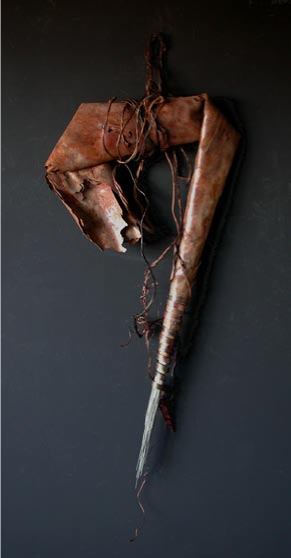 |
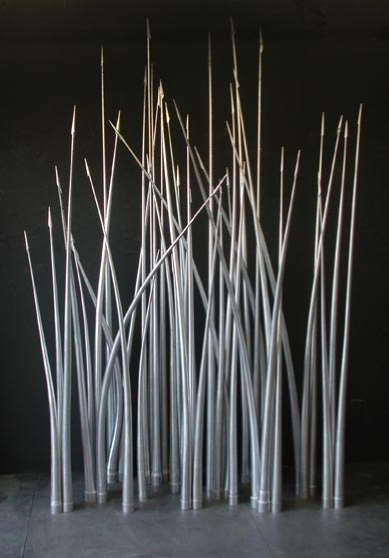 |
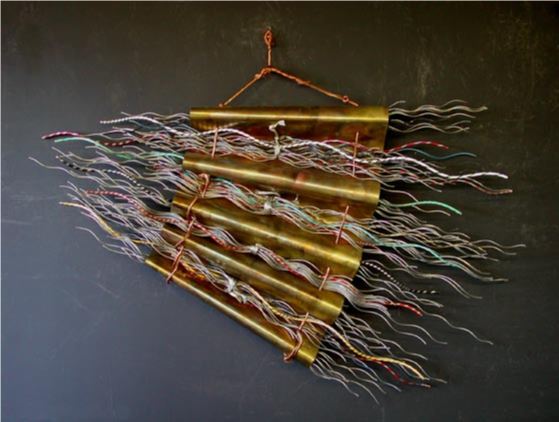 |
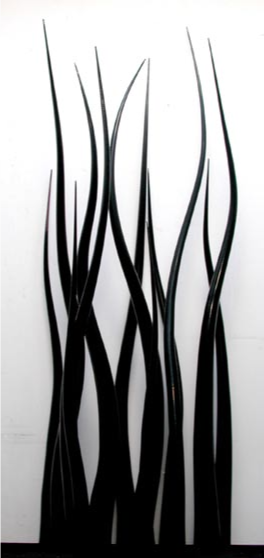 |
 |
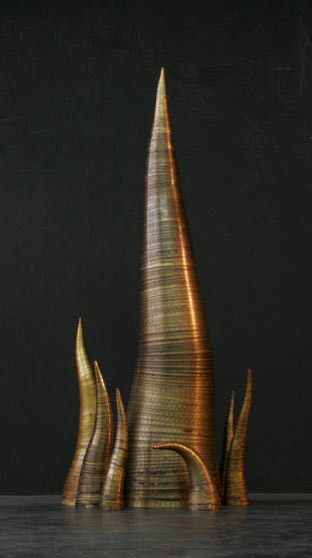 |
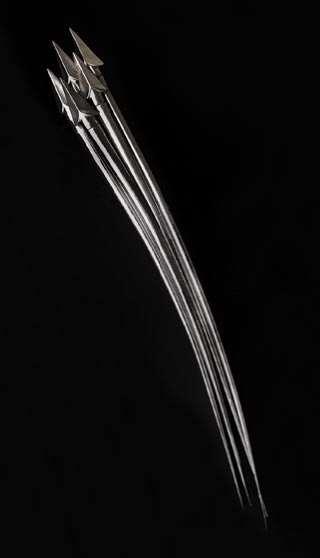 |
 In the final group in this section features objects connected with sacred practices. They link in content with Scribe, Sacred Text and several other artifacts at the beginning of this catalogue.
In the final group in this section features objects connected with sacred practices. They link in content with Scribe, Sacred Text and several other artifacts at the beginning of this catalogue.
Pyramid is 10 feet tall, so elongated that it would be correct to call it a steeple like the tallest, thinnest spire of Rouen Cathedral. It’s a hard, inflexible, unforgiving spike that’s equal in impact but very different in feel from the soft, where the copper tendrils can be spread out to form a large circular base.
Fetish, Reliquary and Torch are ‘primitive’ with their tendrils; and futuristic in their use of lighting. They could be installed reverently in a sanctuary or irreverently in a dungeon. All my works are open to interpretation, names also intended to not limit a viewer to a single reading. Iris and Core share similar forms, loci and a focal point. They maybe like Mandalas.
Oculus, the multi-coloured pupil on the frontispiece, stares fixedly like the eye of a bird of prey. The recent, addition of white and black birds on either side of this ferocious eye transformed Oculus into a work called Oracle. In keeping the latter, the former will be sacrificed. THIRTY YEAR SURVEY: SECTION TWO: will provide photos of and comments on thirty additional works.
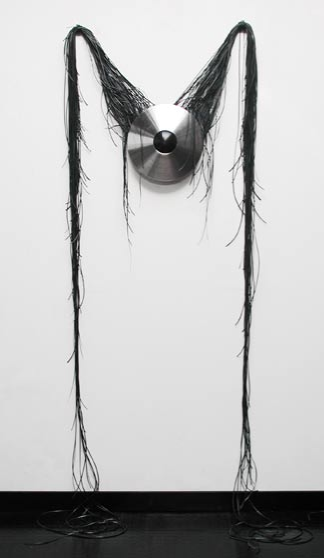 |
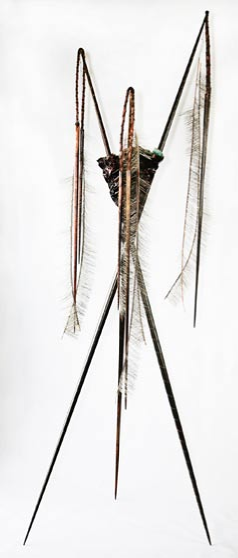 |
 |
 |
 |
 |
SECTION 2: STATEMENT
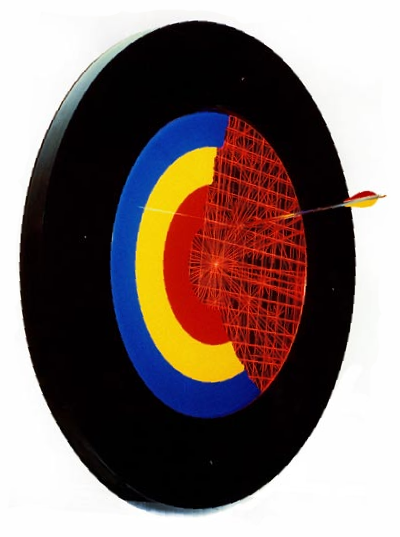 Since I was young I have collected stuff with the intention of making things. This habit was learned from my mother who used to say, “Oh, we could use this for that.” Combine that with the fact that my father had a shop in the basement full of tools, nuts, bolts and materials out of which anything could be made. I often make things from the materials that are at hand.
Since I was young I have collected stuff with the intention of making things. This habit was learned from my mother who used to say, “Oh, we could use this for that.” Combine that with the fact that my father had a shop in the basement full of tools, nuts, bolts and materials out of which anything could be made. I often make things from the materials that are at hand.
After declaring a work finished. I occasionally add things, alter shapes; refinish or dismantle it, sometimes months or years later. All works are works-in-progress and will always be works in-progress. Indeed, I’ve not yet decided what form Oracle will assume.
Section Two features just over thirty works created between 1980 and 2010, including a few repeats of those already illustrated in Section One. This expanded survey affords further glimpses into the forms, symbols and technologies I’ve explored in the last thirty-plus years.
It broadens the spectrum from which a gallery owner or curator might chose when considering work for a group, one person or theme-based exhibition.
Such installations might bring together artworks that have motifs, materials formats or techniques in common. They could also feature pieces endowed with light or ones that are capable of motion.
Circles
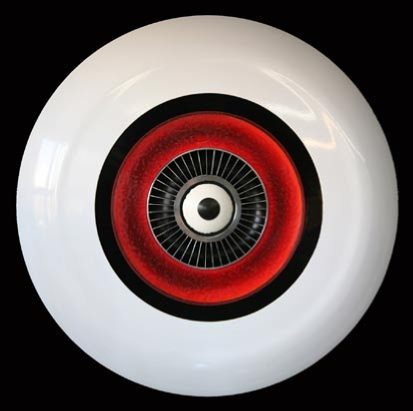 Part A of this survey begins with two objects produced almost thirty years apart—Shot in the Dark (the frontispiece to this section) was made in the early ‘80s and Oculus was fabricated in 2010. The former is reminiscent of the traditional ringed target used in archery but it is pierced by a chrome plated arrow. This projectile pierces a three-layer grid of scored, side-lit Plexiglas. The ‘arrow’ has missed its mark. Shot in the Dark is a visual metaphor for a chance taken. When placed close to Shot in the Dark, Oculus’ design associates with a flying saucer or an optical vortex. It projects the idea of rapid rotation, similar to that of the whirling spokes in Spinner and the turbine’ in Nexus. Nexus’s physical light, although different, links with the neon in Shot in the Dark. Nexus was made in the late 80’s and yet complements Spinner and Oculus produced respectively in the late 90’s and 2010. In addition to whatever else they have in common, the four objects in this sequence have circular formats.
Part A of this survey begins with two objects produced almost thirty years apart—Shot in the Dark (the frontispiece to this section) was made in the early ‘80s and Oculus was fabricated in 2010. The former is reminiscent of the traditional ringed target used in archery but it is pierced by a chrome plated arrow. This projectile pierces a three-layer grid of scored, side-lit Plexiglas. The ‘arrow’ has missed its mark. Shot in the Dark is a visual metaphor for a chance taken. When placed close to Shot in the Dark, Oculus’ design associates with a flying saucer or an optical vortex. It projects the idea of rapid rotation, similar to that of the whirling spokes in Spinner and the turbine’ in Nexus. Nexus’s physical light, although different, links with the neon in Shot in the Dark. Nexus was made in the late 80’s and yet complements Spinner and Oculus produced respectively in the late 90’s and 2010. In addition to whatever else they have in common, the four objects in this sequence have circular formats.
 |
 |
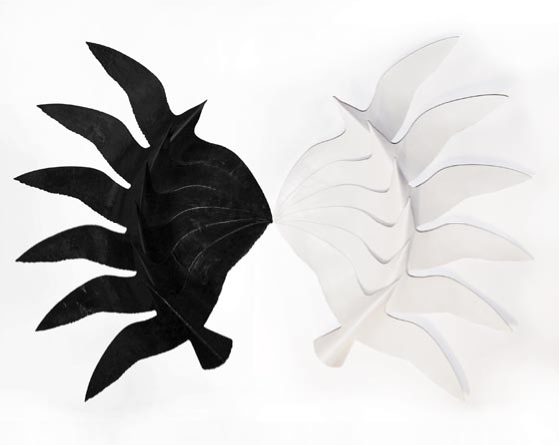 |
 |
“Oculus I changed from a ‘stand-alone’ piece with a circular format when I saw the half-circle patterns of the black and white birds wing tip to wing tip on the floor.” “I realized they formed a circle that was the same size as Oculus (see Oracle-in-progress. 6a & 6b).” With the addition of the black bids on the left and the white birds on the right, a strong black/white pattern was formed that evoked a Chinese yin/yang vision of harmony and balance. The wings endow the central God-like eye with lashes that never close. This version of Oracle might stay the same or change. “Oracle is a sample of the many birds featured in my art over the last three decades, including Flight Path that was commissioned for Vancouver’s EXPO ‘86.”
Birds & Stars
 The commission for Expo’86 was one given to eleven featured artists in the Canada Pavilion. The computer- controlled, delicately-suspended wings of the flock rose and fell as if responding to an air current, they streamed in from the Arctic Pavilion where they were brass to the Main Hall where they became fully chromed. The gear motors and cables that caused the rise and fall were positioned on the other side of the wall, out of public view. Border Line dates from the early ‘80s. In this work, a single bird flies over a transparent, subtly illuminated picket fence into the unknown. “Van Gogh’s final painting of crows flying over a cornfield (that was thought to be a harbinger of his death) inspired my work in which the picket fence is the line of transition.” Nest attempts to contain three birds in a clutter of twigs. Night Fighter is a warrior whose breastplate features an avian night-flyer. The stars dangling from his epaulettes anticipate the star icons in Rise, Lady of the Night and Geode. Cathedral is the last ‘bird-work’ in this series. It was installed in the Patrick Doheny Gallery in Vancouver in1991 as the most imposing building in Home Fires. A polished-brass dove hovers above its roof. This house is elevated on a podium. Wavy filaments of aluminum rise up from within the house, like smoke. In Rise the same filaments also ascend to veil a background of painted stars.
The commission for Expo’86 was one given to eleven featured artists in the Canada Pavilion. The computer- controlled, delicately-suspended wings of the flock rose and fell as if responding to an air current, they streamed in from the Arctic Pavilion where they were brass to the Main Hall where they became fully chromed. The gear motors and cables that caused the rise and fall were positioned on the other side of the wall, out of public view. Border Line dates from the early ‘80s. In this work, a single bird flies over a transparent, subtly illuminated picket fence into the unknown. “Van Gogh’s final painting of crows flying over a cornfield (that was thought to be a harbinger of his death) inspired my work in which the picket fence is the line of transition.” Nest attempts to contain three birds in a clutter of twigs. Night Fighter is a warrior whose breastplate features an avian night-flyer. The stars dangling from his epaulettes anticipate the star icons in Rise, Lady of the Night and Geode. Cathedral is the last ‘bird-work’ in this series. It was installed in the Patrick Doheny Gallery in Vancouver in1991 as the most imposing building in Home Fires. A polished-brass dove hovers above its roof. This house is elevated on a podium. Wavy filaments of aluminum rise up from within the house, like smoke. In Rise the same filaments also ascend to veil a background of painted stars.
 |
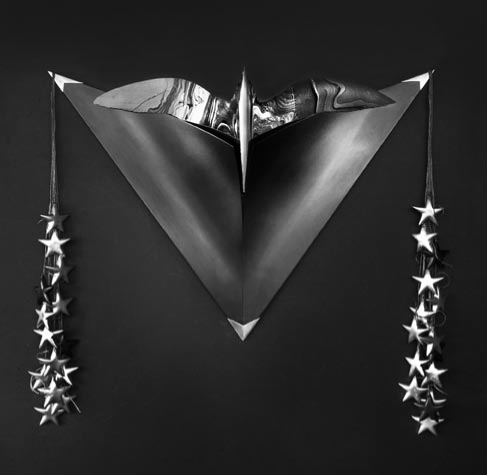 |
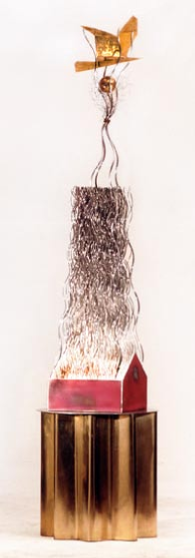 |
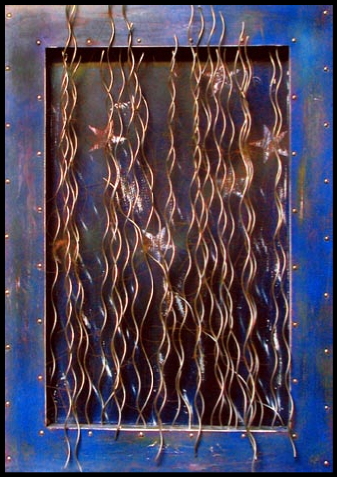 |
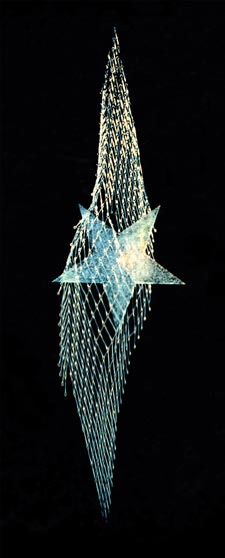 |
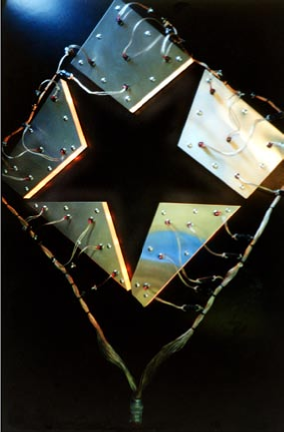 |
Arcs, Frames & Screens
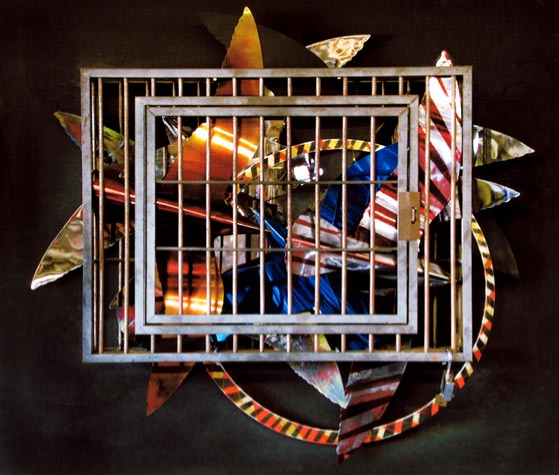 The last section indicates how interpretation of common-place icons like circles, birds and stars was developed over twenty years. This section begins with a group of objects that include an eccentric ‘striped arc’ that was utilized in a few pieces that were principally completed between 2005 and 1995. Bird Cage, which dates from the same period as Nest, includes birds and a striped-circle restrained in a heavy metal cage, that’s too small to contain them. In Machete (a sculpture created around the same time) similar arcs are gathered into a loose ball. In Swirl (a member of the 2000-03 Frames series) straw-like arcs become the skinny arms of a pinwheel that turns in the middle of a fiery, hand-brushed field. Whorl is comprised of similar, but more robust elements organized casually around an implied central locus. In Conundrum, the points of the striped conical hats that terminate each thick cable are, reminiscent of the multi-coloured arcs. As several pieces of the painted aluminum motif are still present in my studio, more arc-related art may be produced in the future.
The last section indicates how interpretation of common-place icons like circles, birds and stars was developed over twenty years. This section begins with a group of objects that include an eccentric ‘striped arc’ that was utilized in a few pieces that were principally completed between 2005 and 1995. Bird Cage, which dates from the same period as Nest, includes birds and a striped-circle restrained in a heavy metal cage, that’s too small to contain them. In Machete (a sculpture created around the same time) similar arcs are gathered into a loose ball. In Swirl (a member of the 2000-03 Frames series) straw-like arcs become the skinny arms of a pinwheel that turns in the middle of a fiery, hand-brushed field. Whorl is comprised of similar, but more robust elements organized casually around an implied central locus. In Conundrum, the points of the striped conical hats that terminate each thick cable are, reminiscent of the multi-coloured arcs. As several pieces of the painted aluminum motif are still present in my studio, more arc-related art may be produced in the future.
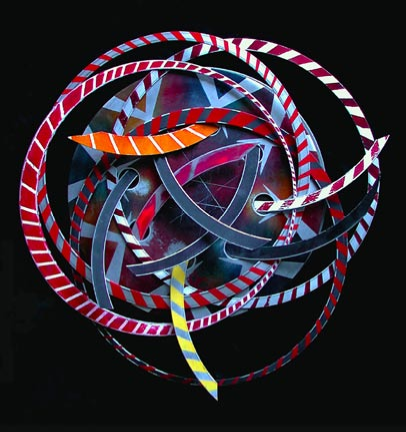 |
 |
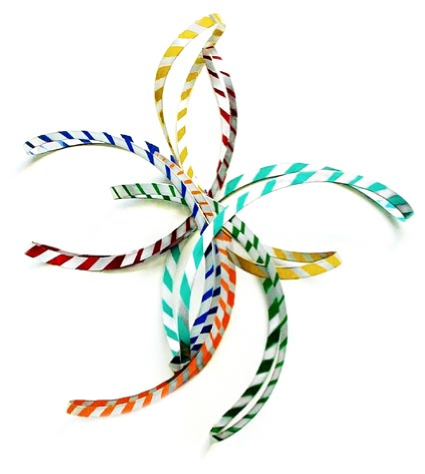 |
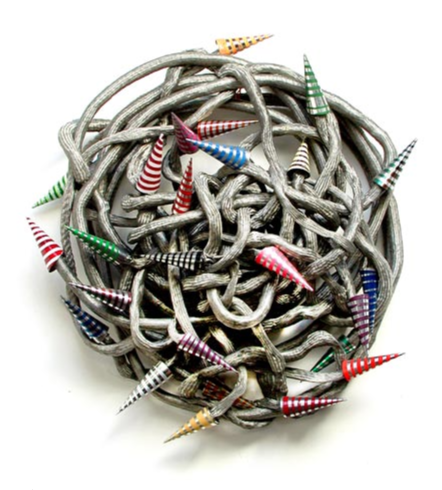 |
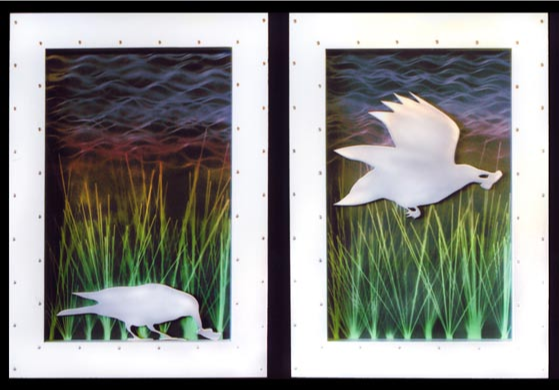
From 2000-2003, twenty-seven wall pieces (set in four- inch wide screwed aluminum frames) were completed. Each frame has 38” x 27” dimensions. All the pieces include sculptural elements. Many exhibit painted backgrounds, painted imagery and even painted frames. There is no unifying theme or painting style but many images are akin to roadside memorials where the viewer is left to ponder about the stories that are behind the objects on view.
Work Ethic Diptych is the only piece with an obvious story. This two-episode narrative is similar to a cartoon or a movie clip.
…Illustrations of Frames (nos 22-27) manifest a diversity of subjects, symbols and moods. The sequence ends with Childhood in which a ‘paper plane’ (formed from a folded piece of lead) rests on the lower ledge of the substantial frame under a cluster of stars held together by a fisherman’s aid.
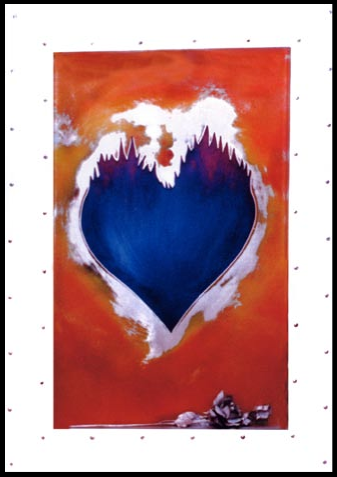 |
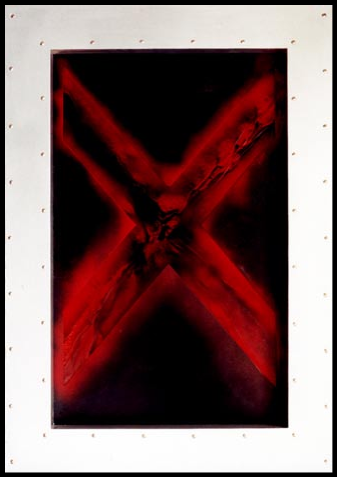 |
 |
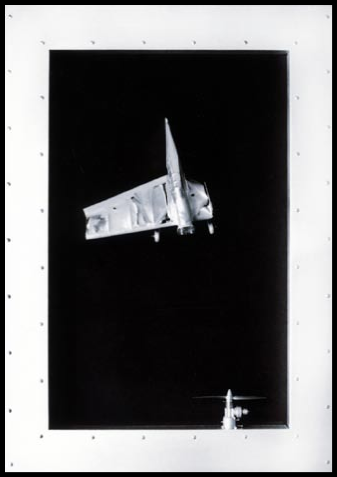 |
Two wall images near the end of Part B are literally Compressions. This name refers to the technique used in sandwiching a variety of fabrics compressed between painted, perforated steel sheets and plywood backings. There is no overriding theme in these 21 pieces that were created from 1990-93. Some of the pieces are quite horrifying yet still humorous, for example, in where stuffing shoots out from a torsos neck or in’stream’ where severed wrists allow rivulets of ribbon to pourout like a skein of wool. These and other works take a unique approach to the use of materials.
 |
 |
 |
 |
Material Essence
 “Much of what I do depends on materials, obtained on impulse like the Lazy Dog missiles I bought in Seattle two decades ago. After examining their complex forms and seeing their potential for an art piece, I acquired a cardboard box containing thousands of the painted steel implements.” When first invented in 1941, Lazy Dog missiles were shaken out of containers equipped with a circular, perforated inserts or tossed from planes in paper bags. They were intended to kill or maim enemy troops. Each missile reached 500 mph by the time it hit the ground. Each weighed only, 07 ounces and was 1.75 inches long, these non-explosive mini-bombs were formidable weapons. In 1983, during the Art and Artists Show in the Vancouver Art Gallery’s new premises in the Old Courthouse, Cloud was installed above the railing of the second storey balcony. From afar, it glittered like an expensive chandelier since each of the 2000 originally drab, khaki–painted elements had been chrome-plated. Of the missles that were remaining were part of Cloud II, a wall piece from the Fames series completed in 2002. The stainless steel rods suspending the bombs are visible against a black sky and convey an impression of speed. The four-inch wide aluminum frame in Cloud II (and those of the twenty-seven other wall-pieces cited in Part B) were fabricated from aluminum sheets that had been EXPO’86’. Before they could be of use all paint and tape was painstakingly removed. As was the case with the missiles I bought, the ‘free’ aluminum also had to be transformed to become what I needed. Even when similar motifs and materials are employed, each piece calls for individual interpretation. In Machete, for example, the striped-arcs are almost playful. Centric features unpainted aluminum half-circles in regular, overlapped patterns oriented away from the low relief’s centre. The arcs ‘press down’ upon a panic button that is the artwork’s hub.
“Much of what I do depends on materials, obtained on impulse like the Lazy Dog missiles I bought in Seattle two decades ago. After examining their complex forms and seeing their potential for an art piece, I acquired a cardboard box containing thousands of the painted steel implements.” When first invented in 1941, Lazy Dog missiles were shaken out of containers equipped with a circular, perforated inserts or tossed from planes in paper bags. They were intended to kill or maim enemy troops. Each missile reached 500 mph by the time it hit the ground. Each weighed only, 07 ounces and was 1.75 inches long, these non-explosive mini-bombs were formidable weapons. In 1983, during the Art and Artists Show in the Vancouver Art Gallery’s new premises in the Old Courthouse, Cloud was installed above the railing of the second storey balcony. From afar, it glittered like an expensive chandelier since each of the 2000 originally drab, khaki–painted elements had been chrome-plated. Of the missles that were remaining were part of Cloud II, a wall piece from the Fames series completed in 2002. The stainless steel rods suspending the bombs are visible against a black sky and convey an impression of speed. The four-inch wide aluminum frame in Cloud II (and those of the twenty-seven other wall-pieces cited in Part B) were fabricated from aluminum sheets that had been EXPO’86’. Before they could be of use all paint and tape was painstakingly removed. As was the case with the missiles I bought, the ‘free’ aluminum also had to be transformed to become what I needed. Even when similar motifs and materials are employed, each piece calls for individual interpretation. In Machete, for example, the striped-arcs are almost playful. Centric features unpainted aluminum half-circles in regular, overlapped patterns oriented away from the low relief’s centre. The arcs ‘press down’ upon a panic button that is the artwork’s hub.
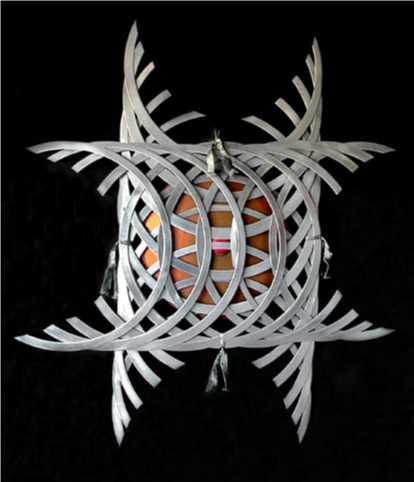
Grid of 1985, forms links with Conundrum, Bird’s Nest, Volcano and Streamer shown in Part B as they all suggest uncomfortable confinement. The wavy aluminum rods in Grid are present in many artworks created from 1990 to the present. In the 1991 Home Fires installation, they were the smoke billowing up from inside the houses including the Cathedral and they were the vapours veiling the sky in the 2002 Rise from the Frames group (see page 9). In Street Fighters of 1985 concentrated bundles of rods engage in a tête-à-tête. This photo-document keeps alive a sculpture that is now dismantled. Silver Kelp, composed of real kelp painted silver in 1990 also exists only as a photograph. “I plan to make more photographs of temporary or dismantled sculptures in the future as mural-sized prints.” For over thirty years, I’ve been making photographs of my art which could have a greater impact on a larger scale. Field could be produced close to its actual real-life dimensions. This is the sort of impromptu, impermanent works I plan to make in the near future out of natural or manufactured items.
 |
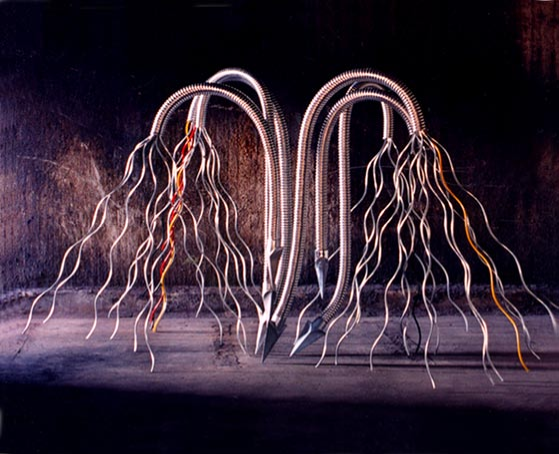 |
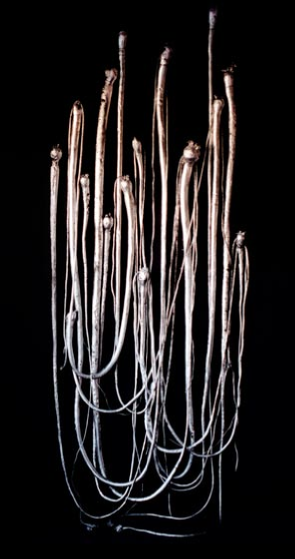 |
 |
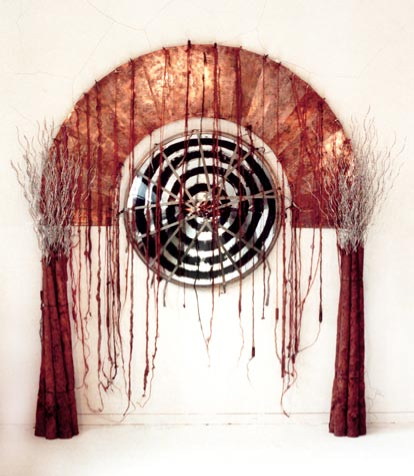 Ceremony’s central host like element is flanked by two wooden trees from which aluminum rods burst like branches. This object, though fashioned in 1985, would fit in well with artifacts made for an installation of the ‘primitive’ society featured in Section One of the on-line two part catalogue and DVD that has been completed in April 2010. There are enough works to form the basis for a third part that could begin where Section Two ends with Crusader (31) of 1980. Hopefully nos. 24-3I at the end of Part C come full circle they stand outside a temple with a copper arch that houses a circular lit maze lake mandula.
Ceremony’s central host like element is flanked by two wooden trees from which aluminum rods burst like branches. This object, though fashioned in 1985, would fit in well with artifacts made for an installation of the ‘primitive’ society featured in Section One of the on-line two part catalogue and DVD that has been completed in April 2010. There are enough works to form the basis for a third part that could begin where Section Two ends with Crusader (31) of 1980. Hopefully nos. 24-3I at the end of Part C come full circle they stand outside a temple with a copper arch that houses a circular lit maze lake mandula.


